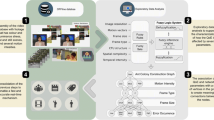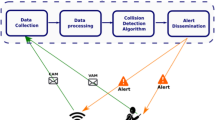Abstract
Vehicular ad-hoc networks (VANETs) are being widely adopted in the last few years. This type of network enables the utilization of a large diversity of distributed applications, such as road and traffic alerts, autonomous driving capabilities and video distribution. Video applications can be considered one of the most demanding services because it needs a steady and continuous flow of information. This presents a set of challenges to VANETs considering their scarce network resources due to the vehicle movement and time-varying wireless channels. Considering the above mentioned issues, an adaptive quality of experience (QoE)-driven mechanism is needed to provide live transmission capabilities to video-equipped vehicles. This mechanism has to overcome the challenges to grant a high-qua lity video transmission without adding any unnecessary network overhead. To this end, a forward error correction (FEC) technique can be adapted to enhance the video distribution, leading to higher QoE for end users. The proposed self-adaptive FEC-based mechanism (SHIELD) uses several video characteristics and specific VANETs details to safeguard real-time video streams against packet losses. One of the main contributions of this work is the combined used of network density, signal-to-noise ratio, packet loss rate, and the vehicle’s position. This allows SHIELD to better protect the video sequences and enhance the QoE. In doing that, we are able to improve the user experience, while saving network resources. The advantages and drawbacks of the proposed mechanism are demonstrated through extensive experiments and assessed with QoE metrics, proving that it outperforms both adaptive and non-adaptive mechanisms.








Similar content being viewed by others
Explore related subjects
Discover the latest articles, news and stories from top researchers in related subjects.Notes
Samples of the transmitted videos are available in http://www.youtube.com/channel/UCsB0SdKpCKD2GS6aXzB-FUQ/videos
References
comScore (2013, February). Brazilian online video audience reaches 43 million unique viewers in december 2012. Technical report, comScore inc. http://www.comscore.com/Insights/Press_Releases/2013/2/Brazilian_On-line_Video_Audience_Reaches_43_Million_Unique_Viewers_in_December_2012.
Adobe Digital Index. (2014). U.S. digital video benchmark report. Technical report, Adobe (Q2 2014).
Zhou, L., Zhang, Y., Song, K., Jing, W., & Vasilakos, A. V. (2011). Distributed media services in p2p-based vehicular networks. IEEE Transactions on Vehicular Technology, 60(2), 692–703.
Gerla, M., Wu, C., Pau, G., & Zhu, X. (2014). Content distribution in VANETs. Vehicular Communications, 1(1), 3–12. doi:10.1016/j.vehcom.2013.11.001.
Immich, R., Cerqueira, E., & Curado, M. (2013). Cross-layer fec-based mechanism for packet loss resilient video transmission. In E. Biersack, C. Callegari, M. Matijasevic (Eds.), Data traffic monitoring and analysis. Lecture notes in computer science (vol. 7754, pp. 320–336). Springer, Berlin. doi:10.1007/978-3-642-36784-7_13.
Immich, R., Cerqueira, E., & Curado, M. (2014). Ensuring qoe in wireless networks with adaptive fec and fuzzy logic-based mechanisms. In 2014 IEEE international conference on communications (ICC) (pp. 1687–1692). doi:10.1109/ICC.2014.6883565.
Soldo, F., Casetti, C., Chiasserini, C., & Chaparro, P. A. (2011). Video streaming distribution in vanets. IEEE Transactions on Parallel and Distributed Systems, 22(7), 1085–1091. doi:10.1109/TPDS.2010.173.
Shen, Z., Luo, J., Zimmermann, R., & Vasilakos, A. V. (2011). Peer-to-peer media streaming: Insights and new developments. Proceedings of the IEEE, 99(12), 2089–2109.
Jiang, T., Wang, H., & Vasilakos, A. V. (2012). Qoe-driven channel allocation schemes for multimedia transmission of priority-based secondary users over cognitive radio networks. IEEE Journal on Selected Areas in Communications, 30(7), 1215–1224.
Bellalta, B., Belyaev, E., Jonsson, M., & Vinel, A. (2014). Performance evaluation of IEEE 802.11p-enabled vehicular video surveillance system. IEEE Communications Letters, 18(4), 708–711. doi:10.1109/LCOMM.2014.022514.140206.
Marwaha, S., Srinivasan, D., Tham, C.K., & Vasilakos, A. (2004). Evolutionary fuzzy multi-objective routing for wireless mobile ad hoc networks. In Congress on evolutionary computation, 2004. CEC2004 (vol. 2, pp. 1964–1971). IEEE.
Zeng, Y., Xiang, K., Li, D., & Vasilakos, A. V. (2013). Directional routing and scheduling for green vehicular delay tolerant networks. Wireless Networks, 19(2), 161–173.
Pham, T. A. Q., Piamrat, K., & Viho, C. (2014). Qoe-aware routing for video streaming over vanets. In 2014 IEEE 80th vehicular technology conference (VTC Fall) (pp. 1–5). doi:10.1109/VTCFall.2014.6966141.
Wu, H., & Ma, H. (2014). Opportunistic routing for live video streaming in vehicular ad hoc networks. In 2014 IEEE 15th international symposium on a world of wireless, mobile and multimedia networks (WoWMoM) (pp. 1–3). doi:10.1109/WoWMoM.2014.6919002.
Zhang, X. M., Zhang, Y., Yan, F., & Vasilakos, A. V. (2015). Interference-based topology control algorithm for delay-constrained mobile ad hoc networks. IEEE Transactions on Mobile Computing, 14(4), 742–754.
Nafaa, A., Taleb, T., & Murphy, L. (2008). Forward error correction strategies for media streaming over wireless networks. IEEE Communications Magazine, 46(1), 72–79. doi:10.1109/MCOM.2008.4427233.
Immich, R., Borges, P., Cerqueira, E., & Curado, M. (2015). QoE-driven video delivery improvement using packet loss prediction. International Journal of Parallel, Emergent and Distributed Systems.
Zhou, L., Chao, H.-C., & Vasilakos, A. V. (2011). Joint forensics-scheduling strategy for delay-sensitive multimedia applications over heterogeneous networks. IEEE Journal on Selected Areas in Communications, 29(7), 1358–1367.
Greengrass, J., Evans, J., & Begen, A. C. (2009). Not all packets are equal, part I: Streaming video coding and sla requirements. IEEE Internet Computing, 13, 70–75. doi:10.1109/MIC.2009.14.
Wan, Z., Xiong, N., Ghani, N., Vasilakos, A., & Zhou, L. (2014). Adaptive unequal protection for wireless video transmission over IEEE 802.11e networks. Multimedia Tools and Applications, 72(1), 541–571. doi:10.1007/s11042-013-1378-z.
Raju, G. V. S., Zhou, J., & Kisner, R. A. (1991). Hierarchical fuzzy control. International Journal of Control, 54(5), 1201–1216. doi:10.1080/00207179108934205.
Rubino, G. (2005). Quantifying the quality of audio and video transmissions over the internet: The PSQA approach. Design and operations of communication networks: A review of wired and wireless modeling and management challenges. London: Imperial College Press.
Asefi, M., Mark, J. W., & Shen, X. (2012). A mobility-aware and quality-driven retransmission limit adaptation scheme for video streaming over vanets. IEEE Transactions on Wireless Communications, 11(5), 1817–1827. doi:10.1109/TWC.2012.030812.111064.
Naeimipoor, F., & Boukerche, A. (2014). A hybrid video dissemination protocol for vanets. In 2014 IEEE international conference on communications (ICC) (pp. 112–117). doi:10.1109/ICC.2014.6883304.
Huynh-Thu, Q., & Ghanbari, M. (2008). Scope of validity of PSNR in image/video quality assessment. Electronics Letters, 44, 800–8011.
Wang, Z., & Hassan, M. (2012). Blind xor: Low-overhead loss recovery for vehicular safety communications. IEEE Transactions on Vehicular Technology, 61(1), 35–45. doi:10.1109/TVT.2011.2172010.
Rezende, C., Almulla, M., & Boukerche, A. (2013). The use of erasure coding for video streaming unicast over vehicular ad hoc networks. In 2013 IEEE 38th conference on local computer networks (LCN), pp. 715–718. doi:10.1109/LCN.2013.6761318.
Immich, R., Cerqueira, E., & Curado, M. (2015). Adaptive qoe-driven video transmission over vehicular ad-hoc networks. In 2015 IEEE conference on computer communications workshops (INFOCOM WKSHPS).
Vlavianos, A., Law, L. K., Broustis, I., Krishnamurthy, S. V., & Faloutsos, M. (2008). Assessing link quality in IEEE 802.11 wireless networks: Which is the right metric? In IEEE 19th international symposium on personal, indoor and mobile radio communications, 2008. PIMRC 2008 (pp. 1–6). doi:10.1109/PIMRC.2008.4699837.
Wan, Z., Xiong, N., & Yang, L. (2015). Cross-layer video transmission over IEEE 802.11e multihop networks. Multimedia Tools and Applications, 74(1), 5–23. doi:10.1007/s11042-013-1447-3.
Martini, M. G., Mazzotti, M., Lamy-Bergot, C., Huusko, J., & Amon, P. (2007). Content adaptive network aware joint optimization of wireless video transmission. IEEE Communications Magazine, 45(1), 84–90. doi:10.1109/MCOM.2007.284542.
Immich, R., Cerqueira, E., & Curado, M. (2014). Towards the enhancement of uav video transmission with motion intensity awareness. In Wireless Days (WD), 2014 IFIP.
Immich, R., Cerqueira, E., & Curado, M. (2013). Adaptive video-aware fec-based mechanism with unequal error protection scheme. In Proceedings of the 28th annual ACM symposium on applied computing (pp. 981–988). ACM.
Barber, C. B., Dobkin, D. P., & Huhdanpaa, H. (1996). The quickhull algorithm for convex hulls. ACM Transactions on Mathematical Software, 22(4), 469–483. doi:10.1145/235815.235821.
Bentley, J. L., Preparata, F. P., & Faust, M. G. (1982). Approximation algorithms for convex hulls. Communications of the ACM, 25(1), 64–68. doi:10.1145/358315.358392.
Wong, K.-W., Tikk, D., Gedeon, T. D., & Koczy, L. T. (2005). Fuzzy rule interpolation for multidimensional input spaces with applications: A case study. IEEE Transactions on Fuzzy Systems, 13(6), 809–819. doi:10.1109/TFUZZ.2005.859316.
Vanne, J., Aho, E., Hamalainen, T. D., & Kuusilinna, K. (2006). A high-performance sum of absolute difference implementation for motion estimation. IEEE Transactions on Circuits and Systems for Video Technology, 16(7), 876–883. doi:10.1109/TCSVT.2006.877150.
Henderson, T. R., Roy, S., Floyd, S., & Riley, G. F. (2006). Ns-3 project goals. In Proceeding from the 2006 workshop on Ns-2: The IP network simulator. WNS2 ’06. ACM, New York, NY. doi:10.1145/1190455.1190468.
Klaue, J., Rathke, B., & Wolisz, A. (2003). Evalvid—A framework for video transmission and quality evaluation. 13th International conference on modeling techniques and tools for computer performance evaluation (pp. 255–272).
Xiph.org Video Test Media [derf’s collection]. http://media.xiph.org/video/derf/.
Jiang, D., & Delgrossi, L. (2008). IEEE 802.11p: Towards an international standard for wireless access in vehicular environments. In IEEE vehicular technology conference, 2008. VTC Spring 2008. (pp. 2036–2040). doi:10.1109/VETECS.2008.458.
Katsaros, K., Dianati, M., Tafazolli, R., & Kernchen, R. (2011). Clwpr—A novel cross-layer optimized position based routing protocol for vanets. In 2011 IEEE vehicular networking conference (VNC) (pp. 139–146). doi:10.1109/VNC.2011.6117135.
Behrisch, M., Bieker, L., Erdmann, J., & Krajzewicz, D. (2011). Sumo–simulation of urban mobility. In The third international conference on advances in system simulation (SIMUL 2011), Barcelona.
Mittag, J., Papanastasiou, S., Hartenstein, H., & Strom, E. G. (2011). Enabling accurate cross-layer PHY/MAC/NET simulation studies of vehicular communication networks. Proceedings of the IEEE, 99(7), 1311–1326. doi:10.1109/JPROC.2010.2103291.
Taliwal, V., Jiang, D., Mangold, H., Chen, C., & Sengupta, R. (2004). Empirical determination of channel characteristics for DSRC vehicle-to-vehicle communication. In Proceedings of the 1st ACM international workshop on vehicular ad hoc networks. VANET ’04 (pp. 88–88). ACM, New York, NY. doi:10.1145/1023875.1023890.
Winkler, S., & Mohandas, P. (2008). The evolution of video quality measurement: From PSNR to hybrid metrics. IEEE Transactions on Broadcasting, 54(3), 660–668. doi:10.1109/TBC.2008.2000733.
Chikkerur, S., Sundaram, V., Reisslein, M., & Karam, L. J. (2011). Objective video quality assessment methods: A classification, review, and performance comparison. IEEE Transactions on Broadcasting, 57(2), 165–182. doi:10.1109/TBC.2011.2104671.
Wang, Z., Bovik, A. C., Sheikh, H. R., & Simoncelli, E. P. (2004). Image quality assessment: From error visibility to structural similarity. IEEE Transactions on Image Processing, 13(4), 600–612. doi:10.1109/TIP.2003.819861.
Pinson, M. H., & Wolf, S. (2004). A new standardized method for objectively measuring video quality. IEEE Transactions on Broadcasting, 50(3), 312–322.
Vatolin, D., Moskin, A., Pretov, O., & Trunichkin, N. Msu video quality measurement tool. http://compression.ru/video/quality_measure/video_measurement_tool_en.html.
Acknowledgments
This work was funded by the Brazilian National Counsel of Technological and Scientific Development (CNPq), and also supported by the COST Action IC1303: AAPELE—Algorithms, Architectures and Platforms for Enhanced Living Environments and FCT Project, MIT-Portugal Program—SusCity: Urban data driven models for creative and resourceful urban transitions.
Author information
Authors and Affiliations
Corresponding author
Rights and permissions
About this article
Cite this article
Immich, R., Cerqueira, E. & Curado, M. Shielding video streaming against packet losses over VANETs. Wireless Netw 22, 2563–2577 (2016). https://doi.org/10.1007/s11276-015-1112-z
Published:
Issue Date:
DOI: https://doi.org/10.1007/s11276-015-1112-z




